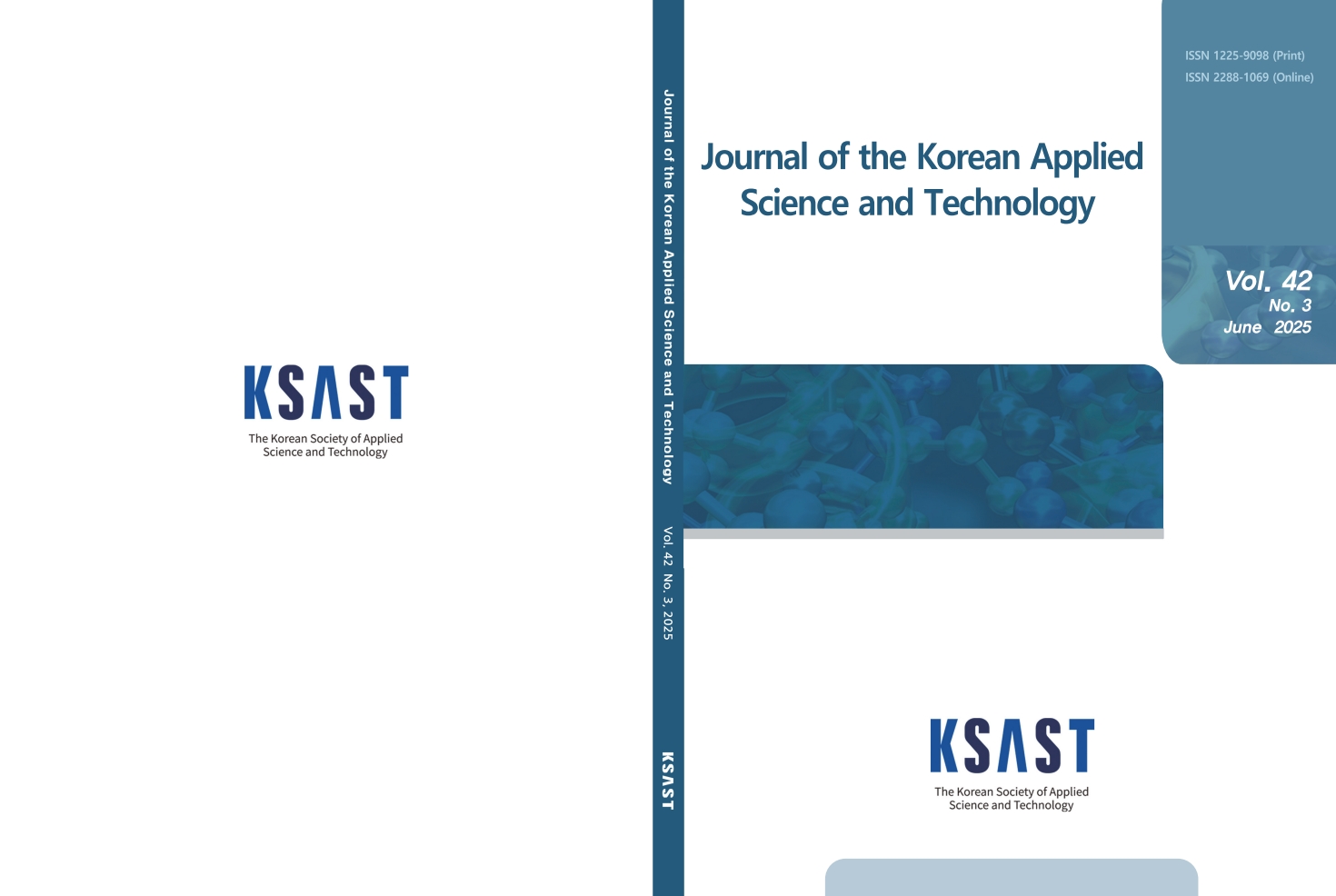한국응용과학기술학회 논문 검색












1. Y. J. Kim, J. Y. Kim, “Behavioral Study on the Use of Cosmetics and Skin-CareProducts among Female University Students in their 20s,” Asian J Beauty Cosmetol,, Vol. 18, No. 4, pp. 587–597, (2020).
https://doi.org/10.20402/ajbc.2020.0080
2. G. Y. Kim, S. S. Han, S. H. Lee, A. K. Kim, “A Study on the comparson of skineffects by natural cosmetics and general cosmetics”, Asian J Beauty Cosmetol, Vol.7, No.4, pp. 225-238, (2009).
3. J. K. Hong, “A Study on Skin Aging Caused by Free-Radical and on Efficacyof Antioxidant Vitamins”, Asian Journal of Beauty and Cosmetology, Vol.7, No.2, pp.
51-62, (2009).
4. H. J. Lee, H. J. Lim, M. H. Lim, “The Activity of Anti-oxidation of Cinnamomumloureiroi Extract”, Journal of the Korean Applied Science and Technolog, Vol.37,
No.6, pp. 1583-1590, (2020).https://doi.org/10.12925/jkocs.2020.37.6.1583
5. S. J. Park, “Antioxidant Activities and Whitening Effects of Ethanol Extractfrom Panax ginseng Sprout Powder”, The Korean Society of Food science and
Nutrition, Vol.48, No.2, pp. 276-281, (2019).https://doi.org/10.3746/jkfn.2019.48.2.276
6. Rice-Evans CA, Miller NJ, Paganga G, “Structure antioxidant activity relationships of flavonoids andphenolic acids”, Free Radical Biology & Medicin., Vol.20, No.7, pp. 933-956, (1996).https://doi.org/10.1016/0891-5849(95)02227-9
7. B.S. Sivamaruthi, C. Chaiyasut, P. Kesika, “Cosmeceutical Importance of Fermented Plant Extracts: a short review“, International Jorunal of Applied Phamaceutics, Vol.10, No.4, pp. 31-34, (2018).http://dx.doi.org/10.22159/ijap.2018v10i4.26355
8. T. J. Kim, J. Y, No, J. S. Go, ”The Separation and Determination of FlavonoidGlycosides from Poncirus trifoliata rafia and Citrus aurantium L“, The Korean
Society of Analytical Sciences, Vol.2, No.2, pp. 301-301, (1989).
9. Heinrich G, Schultze W, Wegner R, "Compartmentation of mono-and sesquiterpenebiosynthesis of the essential oil in Poncirus trifoliata.", Protoplasma, Vol.103, No.1, pp. 115-119, (1980).https://doi.org/10.1007/BF01276670
10. H. S. Chung, J. B, Lee, J. H. Seong, J. U. Choi, “Chemical components in peel and flesh of trifoliate oranges(Poncirus trifoliata)“, Korean Journal of Food
Preservation, Vol.11, No.3, pp. 342-346, (2004).
11. Y. S. Yang, H. G. Yoon, N. W. Kim, ”The Physiological Activities of Ripe Fruitof Poncirus trifoliata”, Food Science and Preservation, Vol.17, No.5, pp. 698-705,
(2010).
12. S. H. Lee, M. S. Lee, “The Study of Antioxidant and Antimicrobial Effects on the Skin Extracts of Citrus junos, Poncirus trifoliata, Jeju citrus”, Journal of Korean Society of beauty and Arts, Vol.18, No.2,pp. 127-140. (2017). https://doi.org/10.18693/jksba.2017.18.2.127
13. M. S. Blois, “Antioxidant determinations by the use of a stable free radical”,Nature, Vol.181, No.4617, pp. 1199–1200, (1958).https://doi.org/10.1038/1811199a0
14. Re R., Pellegrini N., Proteggente A., Pannala A., Yang M., Rice-Evans C.“Antioxidant activity applying an improved ABTS radical cation decolorization assay”, Free Radic Biol Med, Vol.26, No.9-10, pp. 1231–1237, (1999). https://doi.org/10.1016/S0891-5849(98)00315-3
15. M. Y. Choi., H. J. Park., J. S. Kim, M. R. Kim, “Evaluation on antioxidative and antiaging effect of immature fruits from Citrus unshiu Markovich”, The Korea
Journal of Herbology, Vol.36, No.1, pp. 77–85, (2021).https://doi.org/10.6116/KJH.2021.36.1.77.
16. O. C. Kwon, J. H. Shin, M. J. Kang, S. J. Lee, S. Y. Choi, N. J. Sung, “Antioxidant Activity of Ethanol Extracts from Citron (Citrus junos SIEB ex TANAKA) Seed“, The Korean Society of Food Science and Nutrition, Vol.35, No.3, pp. 294-300. http://dx.doi.org/10.3746/jkfn.2006.35.3.294
17. J. H. Shin, S. M. Yang, M. J. Kang, S. J. Lee, S. H. Kim, N. J. Sung, “BiologicalActivities of Hot Water Extracts Made from Yuza(Citrus junos SIEB ex TANAKA) Peel Cultivated in Namhae”, Korean Journal of Food & Cookery Science, Vol.26, No.1, pp. 79-87, (2010). https://doi.org/10.1016/j.bjbas.2016.12.003
18. O. E. Adebiyi, F. O. Olayemi, T. Niug-Hua, Z. Guang-Zhi, “In vitroantioxidant activity, total phenolic and flavonoid contents of ethanol extract of
stem and leaf of Grewia carpinifolia”, Beni-Suef University Journal of Basic andApplied Sciences, Vol. 6, No.1, pp. 10-14, (2017).
https://doi.org/10.1016/j.bjbas.2016.10.003
19. I. S. An, J. H. Kim, H. S. Yoo, R. Zhang, S. M. Kang, T. B. Choe, T. J. Kwon, S. K. An, G. Y. Kim, “The inhibition effect of L-cysteine on melanogenesis in B16F10 mouse melanoma cells”, Asian Journal of Beauty and Cosmetology, Vol.5, No.2 pp. 239-246, (2007).
20. K. A. Hwang, G. R. Kim, Y. J. Hwang, I. G. Hwang, J. Song, “Oxidative StressInhibitory Effects of Low TemperatureAgedGarlic (Allium sativum L.) Extracts
through Free Radical Scavenging Activity“, Korean Society of Food Science andNutrition, Vol.45, No.1, pp. 27-34, (2016).
http://dx.doi.org/10.3746/jkfn.2016.45.1.027
21. J. H, Lee, M. G. Kim, S. Lee, K, H, Leem, “Effects of Bletillae rhizoma on theelastase, collagenase and tyrosinase activities and the procollagen synthesis in
Hs68 human fibroblasts”, The Korea Journal of Herbology, Vol.28, No.1, pp.9-14, (2013). https://doi.org/10.6116/kjh.2013.28.1.9.
22. Spencer JP, “Flavonoids: Modulators of brain function?”, British Journal ofNutrition, Vol. 99, No. 1, pp. ES60-ES77, (2008).
https://doi.org/10.1017/S0007114508965776
23. Cotelle N, “Role of flavonoids in oxidative stress”, Current Topics in MedicinalChemistry, Vol.1, No.6, pp. 569-590, (2001).
https://doi.org/10.2174/1568026013394750
24. S. H. Lee, M. S. Lee, “The Study of Physiological and Antimicrobial Activities on the Citrus Junos Extracts with its Textures and Skin“. Journal of the Korea
Academia-Industrial cooperation Society, Vol.18, No.4, pp. 67-74. (2017).https://doi.org/10.5762/KAIS.2017.18.4.67
25. Y. J. Cho, “Characteristics of cosmetic with whitening compounds fromPhellodendron amurense”, Journal of Applied Biological Chemistry, Vol.54,
No.2, pp. 108-113, (2011). https://doi.org/10.3839/jabc.2011.019

